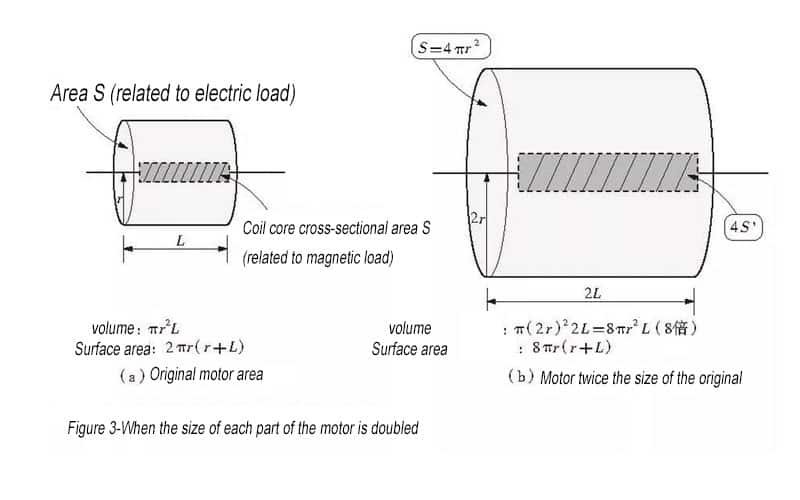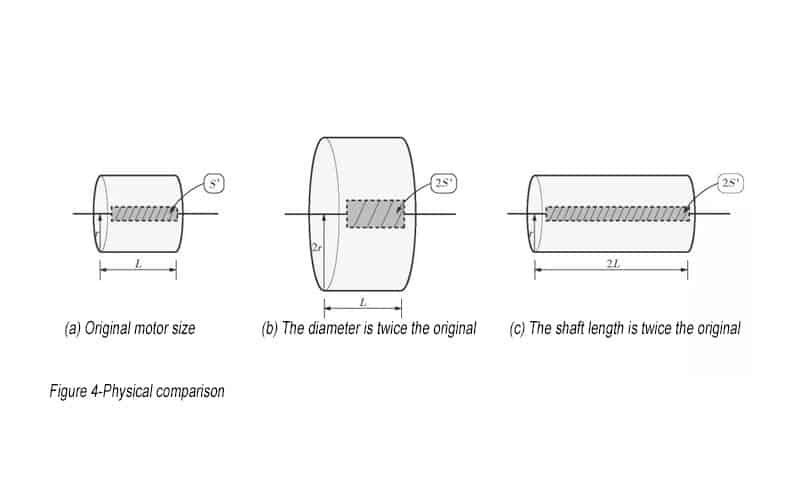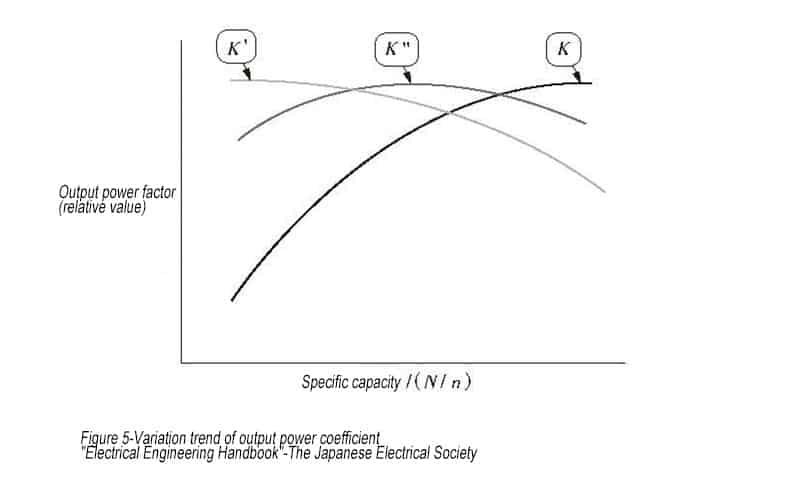Will the size of the motor
affect the motor efficiency
Many dual-motor electric scooter enthusiasts try to DIY their own larger volume, larger diameter motor, so that their cars can run faster, the size of the motor will really affect the motor efficiency?
The answer is: Yes, the size of the motor (size) also determines the motor torque, electrical load, magnetic load, and the motor torque, electrical load, magnetic load is the main factor affecting the efficiency of the motor.
Motor capacity and size “motor capacity” and “output power” are the same?
The term “motor capacity” is used in the terminology of motor specifications. Generally, the motor capacity is considered to be the output power of the motor. However, the unit of output power is W (watts), while the unit of motor capacity is kV-A (kilovolt-amperes). Strictly speaking, the two terms contain different meanings.
Changing the voltage applied to the motor and the coil wire gauge can result in a significant change in the output power of the motor. For example, the motor in the “CQ Brushless Motor and Inverter Kit” has an adjustable power output range of 50 W to 3 kW.
While this range is also an indicator of the motor, we need another indicator to show the potential of the motor itself. This indicator is the motor capacity.
Motor specific capacity = Motor capacity ÷ Rotational speed
It is easier to understand the potential of the motor mentioned earlier when we use the motor specific capacity to express it.
To summarize, even with the same motor, by adjusting the parameters, its output power can change significantly. And, invariably, the speed is increased. Here, by the way, the body (size) of the motor also determines the torque of the motor. Because increasing the motor power means increasing the motor speed.
In other words, no matter how the motor’s output power is adjusted to increase or decrease, the average capacity per revolution, if considered in terms of “specific capacity”, the motor’s potential remains almost the same. For example, it is like the exhaust volume of an engine.
Even an engine with the same exhaust volume can be adjusted to change its power output. The big picture is the relationship between the exhaust volume and the characteristics of the engine.
What happens to the motor capacity when you change the body (size) of the motor?
What exactly is the potential that the motor has? If this potential does exist, how does it relate to the size of the motor? Next, let’s examine the relationship between motor capacity and motor size. Here, FIDICO engineers have compiled as much as two or three pages from the book about the relationship between motor size and motor capacity.
Changing the size of the motor: changing the size of each part to twice the original siz
Let’s take a look at a specific example of changing the size of a motor. First, we change the dimensions of each part of the motor (length, width and height) to twice the original size

Electrical load
The core size becomes twice as large, which means that the core area is 4 times larger and the space available for winding becomes 4 times larger. Assuming that the number of turns of the coil remains the same and the cross-sectional area of the coil becomes 4 times larger, the current flowing through the coil is 4 times larger than before with the same current density. In other words, the electrical load of the motor is 4 times higher than before.
Magnetic load
The size of the motor becomes twice the original size and the cross-sectional area of the core becomes 4 times the original size.
If the current density and the flux density through the core remain the same, the core’s ability to pass the flux is 4 times greater than before.
The magnetic load of the motor is also 4 times higher. From the above, it can be seen that the output power (to be precise, the output power potential of the motor, i.e., the capacity) of a motor with 2 times the original size is 4 x 4 = 16 times.
In other words, if the size of a 10kW motor is changed to 2 times the original size, the output power becomes 160kW. of course, if the size of each part of the motor is changed to 2 times the original size, the volume of the motor is 2×2×2=8 times the original size.
If the volume of the motor becomes 8 times the original size, the mass and material cost of the motor should also be 8 times the original size if the material of each part remains unchanged. In other words, we get 16 times the capacity of the motor with 8 times the material.
Why is it that the larger the size of the motor, the more efficient it is?
What happens to the losses of the motor when its size becomes 8 times larger? Assuming that its copper and iron losses remain the same (because the current density and flux density do not change), the losses and mass of the motor are also 8 times higher.
Up to here, we know: the motor capacity (power) increases to 16 times, the motor loss increases by 8 times. Therefore, the larger the motor’s size, the higher the efficiency.
This is the reason why most industrial motors are big and heavy. It can also be explained that the larger and heavier the motor, the easier it is to achieve high efficiency.
EV motors do not have the size advantage?
The larger the size of the motor, the higher the efficiency. So, wouldn’t it be possible to use a larger size motor for EV?
Here is where the difference between motors for cars and motors for EVs comes into play. As we mentioned earlier, a motor that is mounted on a car consumes energy by its own mass.
Therefore, even if the efficiency of the motor is high, the increase in mass leads to an increase in energy consumption, and the large size of the motor is not suitable to be mounted on a car.
There are many types of motors, and in a sense it can also be said that motors for automobiles are specially designed. It can also be said that motors for automobiles have evolved because of the many limitations in size, shape, and mass.
Heat generation problem of motors with large size
The larger the motor size, the higher the efficiency. At the same time, there is the problem of heat generation. The surface area of a motor with two times the original size of each part is 2×2=4 times the original size, and the heat dissipation area is also 4 times the original size. This is a serious problem. Think about it, the motor has 16 times the original capacity, 8 times the original loss (heat generation), and only 4 times the original heat dissipation area. Obviously, the cooling of the motor is not sufficient, and the motor temperature will rise even higher. Therefore, in order to cope with the heat generation of the motor, it is necessary to add heat dissipation fans or water cooling equipment, etc. Nevertheless, the heat dissipation of the motor is still a subject.
Motor outside diameter, shaft length, capacity outside diameter and shaft length, and D 2L and D 3L
The motor is a device with a long history, but until now there are still many unanswered questions. Like the “three-body problem” in astronomy, the motor involves three major energy-related problems: electricity, magnetism, and mechanics, all of which are intricately related to each other.
Here, we will discuss the topic related to the body/capacity of the motor. When it comes to the body of the motor, it is not the volume capacity that matters. Even if the volume capacity is the same, there are still two influencing elements, the outside diameter and the shaft length.
In the field of electric motors, there is a D 2L that says that the capacity of a motor is proportional to the diameter (to be precise, the diameter of the air gap between the rotor and the stator of the motor) squared.
(to be precise, the diameter of the air gap between the rotor and the stator of the motor) squared and proportional to the shaft length (to be precise, the length of the core).
In fact, there is also the D 3L theory. The author agrees with the latter. However, this is related to the type and capacity of the motor, and it is not possible to say which statement is correct and which is not.
From the motors I have used, it is closer to the D 3L theory. This is a very interesting topic, and the following is a brief explanation of it in the context of the motor’s size (diameter, shaft length).
Changing the size of the motor: changing the diameter and shaft length
Figures 4(a) and (b) show the difference in the size of the motor. First, let us reason from the point of view of electrical and magnetic loads. When the diameter is twice the original, the electrical load is 4 times the original. When we look at the magnetic load, the diameter becomes 2 times the original, and the cross-sectional area of the core (cross-sectional area of the magnetic circuit) becomes 2 times the original in the radial direction, while the area remains the same in the axial direction. In other words, the magnetic load becomes twice as large as before. The motor capacity becomes 4 x 2 = 8 times.

When the diameter remains the same and the shaft length is twice as long
Next, let’s keep the diameter the same and make the shaft length twice as long [Figure 4(c)]. This is the “build-up” method that I often use when making motors.
In this case, what happens to the motor capacity? First, the electric load does not change because the diameter remains the same (because the winding space remains the same).
The magnetic load increases to twice as much as before because the shaft length becomes twice as long (the cross-sectional area of the magnetic circuit is twice as much as before). Therefore, the motor capacity is 1×2=2 times of the original.
In summary, the motor capacity is proportional to D 3L. Of course, we also have to consider the motor’s heat dissipation measures.
Examination of D 2L: Is the target motor different?
As mentioned earlier, the motor capacity is proportional to D 3L. And in general, D 2L is said to be more dominant. Presumably the reason for this lies in the different methods of calculating the electrical load. In the past with brushed motors and induction motors, the winding space was in a sense limited. For example, in a brush motor, even if the diameter becomes twice as large, the winding space does not simply become four times as large.
In a brushed motor, the size of the core in the circumferential direction can become twice as large, but the radial dimension is almost unchangeable. The same applies to induction motors. In distributed coils, the inlay depth is too large, resulting in an increase in the number of connecting wires.
In addition to the disadvantages caused by this (increased mass and volume, reduced efficiency), it also causes problems such as differences in coil induction (coils closer to the center of the core have stronger induction than those closer to the surface). The same is true for large motors used in industry.
Even if the diameter of the rotor is increased, it is better to install the coils close to the surface. This makes the motor larger in the circumferential direction, but almost constant in the radial direction. In this way, the electrical load is not proportional to D 2 , but to D At the same time, the magnetic load is also proportional to D.
Thus, it becomes that the capacity N is proportional to D 2L. In terms of motor size (size), D 3L is more convincing if the brushless motor (concentric winding) that I have used is the object of examination.
There are many theories on the relationship between motor capacity and motor size.
The equation called the output power equation in the Electrical Engineering Handbook (edited by the Japan Electrical Society) also contains information about motor capacity. The details are as follows.

Where N denotes output power (kW) or capacity (kVA); D , L denote armature core diameter and length (m), respectively; and K , K ‘, K” denote output coefficients of various doctrines. Regarding the output coefficient, the trend is shown in Figure 5.

Eq. (1) is the D 2L theory and Eq. (2) is the D 3L theory. By comparing the two doctrines in Fig. 5, it can be seen that the coefficient of D 3L in the area of small capacity (small motors) is basically unchanged and the coefficient of D 2L varies greatly; on the contrary, in the area of large capacity (large motors), the coefficient of D2L varies less. Eq. (3) is obtained by improving the two doctrines, which can be applied to different motors, and can be to be considered as general in a certain region. This description is also the basis for the author’s recommendation of the D 3L theory.



